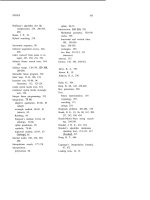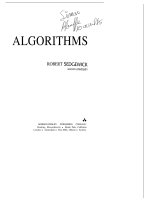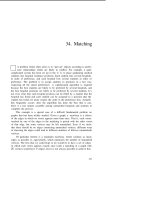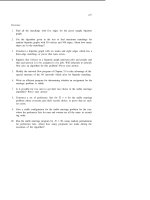Tài liệu Thuật toán Algorithms (Phần 24) pptx
Bạn đang xem bản rút gọn của tài liệu. Xem và tải ngay bản đầy đủ của tài liệu tại đây (79.7 KB, 10 trang )
RADlX SEARCHING
223
same technique as used in Patricia can
be
used in binary radix trie searching
to eliminate one-way branching, but this only exacerbates the multiple node
type problem.
Unlike standard binary tree search, the radix methods are insensitive to
the order in which keys are inserted;
thtty
depend only upon the structure of
the keys themselves. For Patricia the pl,icement of the upwards links depend
on the order of insertion, but the tree structure depends only on the bits in
the keys, as for the other methods. This, even Patricia would have trouble
with a set of keys like 001, 0001, 00001, 300001, etc., but for normal key sets,
the tree should be relatively well-balanced so the number of bit inspections,
even for very long keys, will be roughly proportional to 1gN when there are
N nodes in the tree.
The most useful feature of radix trie searching is that it can be done
efficiently with keys of varying length. In all of the other searching methods
we have seen the length of the key is “built into” the searching procedure in
some way, so that the running time is
dependent
on the length of the keys
as well as the number of keys. The spetific savings available depends on the
method of bit access used. For example, suppose we have a computer which
can efficiently access g-bit “bytes” of tlata, and we have to search among
hundreds of
lOOO-bit
keys. Then Patricia would require access of only about
9 or 10 bytes of the search key for thl: search, plus one 125-byte equality
comparison while hashing requires
accest
of all 125-bytes of the search key for
computing the hash function plus a few elluality comparisons, and comparison-
based methods require several long comparisons. This effect makes Patricia
(or radix trie searching with one-way branching removed) the search method
of choice when very long keys are involved.
224
Exercises
1.
2.
3.
4.
5.
6.
7.
8.
9.
10.
Draw the digital search tree that results when the keys E A S Y Q U E
S
T I 0 N are inserted into an initially empty tree (in that order).
Generate a 1000 node digital search tree and compare its height and the
number of nodes at each level against a standard binary search tree and
a red-black tree (Chapter 15) built from the same keys.
Find a set of 12 keys that make a particulary badly balanced digital
search trie.
Draw the radix search trie that results when the keys E A S Y Q U E S
T I 0 N are inserted into an initially empty tree (in that order).
A problem with 26-way multiway radix search tries is that some letters
of the alphabet are very infrequently used. Suggest a way to fix this
problem.
Describe how you would delete an element from a multiway radix search
tree.
Draw the Patricia tree that results when the keys E A S Y Q U E S T I
0 N are inserted into an initially empty tree (in that order).
Find a set of 12 keys that make a particulary badly balanced Patricia
tree.
Write a program that prints out all keys in a Patricia tree having the
same initial t bits as a given search key.
Use a least-squares curvefitter to find values of a and b that give the best
formula of the form UN 1gN + bN for describing the total number of
instructions executed when a Patricia tree is built from N random keys.
18. External Searching
Searching algorithms appropriate for accessing items from very large
files are of immense practical impcrtance. Searching is the fundamental
operation on large data files, and certainly consumes a very significant fraction
of the resources used in many computer installations.
We’ll be concerned mainly with met hods for searching on large disk files,
since disk searching is of the most practical interest. With sequential devices
such as tapes, searching quickly
degenel.ates
to the trivially slow method: to
search a tape for an item, one can’t do much better than to mount the tape
and read until the item is found. Remarkably, the methods that we’ll study
can find an item from a disk as large as
;L
billion words with only two or three
disk accesses.
As with external sorting, the “systems” aspect of using complex I/O
hardware is a primary factor in the perfo.mance of external searching methods
that we won’t be able to study in detai:. However, unlike sorting, where the
external methods are really quite differer.t from the internal methods, we’ll see
that external searching methods are
1ogil:al
extensions of the internal methods
that we’ve studied.
Searching is a fundamental operaticIn for disk devices. Files are typically
organized to take advantage of particular. device characteristics to make access
of information as efficient as possible.
A3
we did with sorting, we’ll work with
a rather simple and imprecise model of ‘disk” devices in order to explain the
principal characteristics of the fundamental methods. Determining the best
external searching method for a particlllar application is extremely compli-
cated and very dependent on characteristics of the hardware (and systems
software), and so it is quite beyond the scope of this book. However, we can
suggest some general approaches to use.
For many applications we would like to frequently change, add, delete
or (most important) quickly access small bits of information inside very, very
225
CHAPTER
18
large files. In this chapter, we’ll examine some methods for such dynamic
situations which offer the same kinds of advantages over the straightforward
methods that binary search trees and hashing offer over binary search and
sequential search.
A very large collection of information to be processed using a computer
is called a database. A great deal of study has gone into methods of building,
maintaining and using databases. However, large databases have very high
inertia: once a very large database has been built around a particular searching
strategy, it can be very expensive to rebuild it around another. For this reason,
the older, static methods are in widespread use and likely to remain so, though
the newer, dynamic methods are beginning to be used for new databases.
Database applications systems typically support much more complicated
operations than a simple search for an item based on a single key. Searches
are often based on criteria involving more than one key and are expected to
return a large number of records. In later chapters we’ll see some examples
of algorithms which are appropriate for some search requests of this type,
but general search requests are sufficiently complicated that it is typical to do
a sequential search over the entire database, testing each record to see if it
meets the criteria.
The methods that we will discuss are of practical importance in the im-
plementation of large file systems in which every file has a unique identifier
and the purpose of the file system is to support efficient access, insertion and
deletion based on that identifier. Our model will consider the disk storage
to be divided up into pages, contiguous blocks of information that can be
efficiently accessed by the disk hardware. Each page will hold many records;
our task is to organize the records within the pages in such a way that any
record can be accessed by reading only a few pages. We assume that the
I/O time required to read a page completely dominates the processing time
required to do any computing involving that page. As mentioned above, this
is an oversimplified model for many reasons, but it retains enough charac-
teristics of actual external storage devices to allow us to consider some of the
fundamental methods which are used.
Indexed Sequential Access
Sequential disk searching is the natural extension of the elementary sequential
searching methods that we considered in Chapter 14: the records are stored
in increasing order of their keys, and searches are done by simply reading
in the records one after the other until one containing a key greater than or
equal to the search key is found. For example, if our search keys come from
E X T E R N A L S E A R C H I N G E X A M P L E and we have disks
capable of holding three pages of four records each, then we would have the
configuration:
EXTERNAL SEARCHING
227
Diskl. A A A C E E E E EGHI
Disk
Z?:
L L M N NPRR STXX
As with external sorting, we must consider very small examples to under-
stand the algorithms but think about ve y large examples to appreciate their
performance. Obviously, pure sequentizl searching is unattractive because,
for example, searching for W in the exainple above would require reading all
the pages.
To vastly improve the speed of a search, we can keep, for each disk, an
“index” of which keys belong to which pages on that disk, as in the following
example:
Disk 1:
*lc2e
AAAC
EEEE
Disk
,Z:
eli2n
EGHI
LLMN
Disk3:
nlr2x
NPRR
S T X X
The first page of each disk is its index: lower case letters indicate that
only the key value is stored, not the full record; numbers are page indices.
In the index, each page number is
folloTved
by the value of its last key and
preceded by the value of the last key on the previous page. (The
“*”
is a
sentinel key, smaller than all the others.) Thus, for example, the index for
disk 2 says that its first page contains records with keys between E and I
inclusive and its second page contains records with keys between I and N
inclusive. Normally, it should be
possil)le
to fit many more keys and page
indices on an index page than records on a “data” page; in fact, the index for
a whole disk should require only a few pages. These indices are coupled with
a “master index” which tells which keys are on which disk. For our example,
the master index would be
U*
1 e 2 n 3 x,” where boldface integers are disk
numbers. The master index is likely to be small enough that it can be kept
in memory, so that most records can be found with only two pages accessed,
one for the index on the appropriate disl. and one for the page containing the
approriate record. For example, a
searc.h
for W would involve first reading
the index page from disk 3, then reading the second page (from disk 3) which
is the only one that could contain W.
Sc:arches
for keys which appear in the
index require reading three pages the irdex plus the two pages flanking the
key value in the index. If no duplicate keys are in the file, then the extra page
access can be avoided. On the other
hansl,
if there are many equal keys in the
228
CHAPTER 18
file, several page accesses might be called for (records with equal keys might
fill several pages).
Because it combines a sequential key organization with indexed access,
this organization is called indexed sequential. It is the method of choice for
applications where changes to the database are likely to be made infrequently.
The disadvantage of using indexed sequential access is that it is very inflexible.
For example, adding B to the configuration above requires that virtually the
whole database be rebuilt, with new positions for many of the keys and new
values for the indices.
B-Trees
A better way to handle searching in a dynamic situation is to use balanced
trees. In order to reduce the number of (relatively expensive) disk accesses, it
is reasonable to allow a large number of keys per node so that the nodes have
a large branching factor. Such trees were named B-trees by R. Bayer and
E. McCreight, who were the first to consider the use of multiway balanced
trees for external searching. (Many people reserve the term “B-tree” to
describe the exact data structure built by the algorithm suggested by Bayer
and McCreight; we’ll use it as a generic term to mean “external balanced
trees.“)
The top-down algorithm that we used for 2-3-4 trees extends readily to
handle more keys per node: assume that there are anywhere from 1 to M
-
1
keys per node (and so anywhere from 2 to M links per node). Searching
proceeds in a way analogous to 2-3-4 trees: to move from one node to the
next, first find the proper interval for the search key in the current node and
then exit through the corresponding link to get to the next node. Continue
in this way until an external node is reached, then insert the new key into
the last internal node reached. As with top-down 2-3-4 trees, it is necessary
to “split” nodes that are “full” on the way down the tree: any time we see
a k-node attached to an M node, we replace it by a (k + 1)-node attached
to two M/2 nodes. This guarantees that when the bottom is reached there
is room to insert the new node. The B-tree constructed for M = 4 and our
sample keys is diagrammed below:
EXTERNAL SEARCHING 229
This tree has 13 nodes, each corresponding to a disk page. Each node must
contain links as well as records. The
choice
M = 4 (even though it leaves us
with familiar 2-3-4 trees) is meant to emphasize this point: before we could
fit four records per page, now only
three!
will fit, to leave room for the links.
The actual amount of space used up depends on the relative size of records
and links. We’ll see a method below wh ch avoids this mixing of records and
links.
For example, the root node might
bl:
stored as “10 E 11 N 12”, indicating
that the root of the subtree containing records with keys less than or equal
to E is on page 0 of disk 1, etc. Just as
‘ve
kept the master index for indexed
sequential search in memory, it’s reasonable to keep the root node of the B-
tree in memory. The other nodes for
ou:’
example might be stored as follows:
Disk
1:
20 A 21 22 E 30 H
31
L
32
40 R 41 T 42
Disk,!?:
OAO
OAOCOEO OEO
Disk
3:
0 E 0 GO 0 I 0 OLOMO
Disk
4 :
ONOPORO
OS0
0X0X0
The assignment of nodes to disk pages in this example is simply to proceed
down the tree, working from right to
l&
at each level, assigning nodes to
disk 1, then disk 2, etc. In an actual
ihpplication,
other assignments might
be indicated. For example, it might
bt:
better to avoid having all searches
going through disk 1 by assigning first to page 0 of all the disks, etc. In
truth, more sophisticated strategies are needed because of the dynamics of
the tree construction (consider the
diffic:ulty
of implementing a split routine
that respects either of the above strategies).
The nodes at the bottom level in
t1
e B-trees described above all contain
many 0 links which can be eliminated
1)~
marking such nodes in some way.
Furthermore, a much larger value of M
1:an
be used at the higher levels of the
tree if we store just keys (not full records) in the interior nodes as in indexed
sequential access. To see how to take
aclvantage
of these observations in our
example, suppose that we can fit up to
seven
keys and eight links on a page, so
that we can use M = 8 for the interior rodes and M = 5 for the bottom-level
nodes (not M = 4 because no space for 1 nks need be reserved at the bottom).
A bottom node splits when a fifth record is added to it; the split involves
“inserting” the key of the middle recortl into the tree above, which operates
as a normal B-tree from M = 8 (on stored keys, not records). This leads to
the following tree:
230
CHAPTER 18
The effect for a typical application is likely to be much more dramatic since
the branching factor of the tree is increased by roughly the ratio of the record
size to key size, which is likely to be large. Also, with this type of organization,
the “index” (which contains keys and links) can be separated from the actual
records, as in indexed sequential search:
Diskl: 11 112 20 a 21 e 22 e 30 h 31 32 n 40 r 41
s
42
Disk
R:
A A A C E E E
Disk 3: E E G H I L L M
Disk4: N N P R R
S
T X X
As before, the root node is kept in memory. Also the same issues as discussed
above regarding node placement on the disks arise.
Now we have two values of M, one for the interior nodes which determines
the branching factor of the tree (MI) and one for the bottom-level nodes which
determines the allocation of records to pages (MB). To minimize the number
of disk accesses, we want to make both MI and
MB
as large as possible, even
at the expense of some extra computation. On the other hand, we don’t want
to make
MI
huge, because then most tree nodes would be largely empty and
space would be wasted and we don’t want to make
MB
huge because this
would reduce to sequential search of the bottom-level nodes. Usually, it is
best to relate both MI and
MB
to the page size. The obvious choice for
MB
is the number of records that can fit on a page: the goal of the search is to
find the page containing the record sought. If MI is taken to be the number
of keys that can fit on two to four pages, then the B-tree is likely to be only be
three levels deep, even for very large files (a three-level tree with MI = 1024
can handle up to 10243, or over a billion, entries). But recall that the root
node of the tree, which is accessed for every operation on the tree, is kept in
memory, so that only two disk accesses are required to find any element in
the file.
As discussed in Chapter 15, a more complicated “bottom-up” insertion
method is commonly used for B-trees, though the distinction between
top-
EXTERNAL. SEARCHING
231
down and bottom up methods loses iml)ortance for three level trees. Other
variations of balanced trees are more iriportant for external searching. For
example, when a node becomes full, sp itting (and the resultant half-empty
nodes) can be forestalled by dumping some of the contents of the node into
its “brother” node (if it’s not too full). This leads to better space utilization
within the nodes, which is likely to be o
’
central concern in a large-scale disk
searching application.
Extendible Hashing
An alternative to B-trees which extends digital searching algorithms to apply
to external searching was developed in 1978 by R. Fagin, J. Nievergelt, N.
Pippenger, and R. Strong. This method, called extendible hashing, guarantees
that no more than two disk accesses will be used for any search. As with
E
trees, our records are stored on pages which are split into two pieces when
they fill up; as with indexed sequential access, we maintain an index which
we access to find the page containing the records which match our search key.
Extendible hashing combines these approaches by using digital properties of
the search keys.
To see how extendible hashing
worlcs,
we’ll consider how it handles suc-
cessive insertions of keys from E X T E R N A L S E A R C H I N G E X A
M P L E, using pages with a capacity o * up to four records.
We start with an “index” with just one entry, a pointer to the page
which is to hold the records. The first four records fit on the page, leaving
the following trivial structure:
Disk
1:
;
0
Disk
2:
ZETX
The directory on disk 1 says that all records are on page 0 of disk 2, where
they are kept in sorted order of their
keys.
For reference, we also give the
binary value of the keys, using our standard encoding of the five-bit binary
representation of i for the ith letter of the alphabet. Now the page is full,
and must be split in order to add the
ks:y
R=lOOlO. The strategy is simple:
put records with keys that begin with
0
on one page and records with keys
that begin with 1 on another page. Thi: necessitates doubling the size of the
directory, and moving half the keys from page 0 of disk 2 to a new page,
leaving the following structure:
232
CHAPTER 18
0: I$101 E
0101 E
1:
4
10010 R
Disk 1:
20
21
10100 T
Disk
Z?:
E E
RTX
111000 x
Now
N=OlllO
and A=00001 can be added, but another split is needed
before L=OllOO can be added:
0:
0001 A
0101 E
Disk 1: 20
21
Disk2:AEEN
RTX
10100 T
11000 x
Recall our basic assumption that we do disk I/O in page units, and that
processing time is negligible compared to the time to input or output a page.
Thus, keeping the records in sorted order of their keys is not a real expense:
to add a record to a page, we must read the page into memory, modify it,
and write it back out. The extra time required to insert the new record to
maintain sorted order is not likely to be noticable in the typical case when
the pages are small.
Proceeding in the same way, as for the first split, we make room for L=
01100 by splitting the first page into two pieces, one for keys that begin with 00
and one for keys that begin with 01. What’s not immediately clear is what to
do with the directory. One alternative would be to simply add another entry,
one pointer to each page. This is unattractive because it essentially reduces
to indexed sequential search (albeit a radix version): the directory has to be
scanned sequentially to find the proper page during a search. Alternatively,
we can just double the size of the directory again, giving the structure:
00: 0 001 A
0 101 E
0 101 E
01: 01110 L
i
DiskI:
01110 N Disk,!?: A E E LN RTX
10: 1 010 R
11: 1 100 T
11000 x
Now we can access any record by using the first two bits of its key to access
directly the directory entry that contains the address of the page containing









